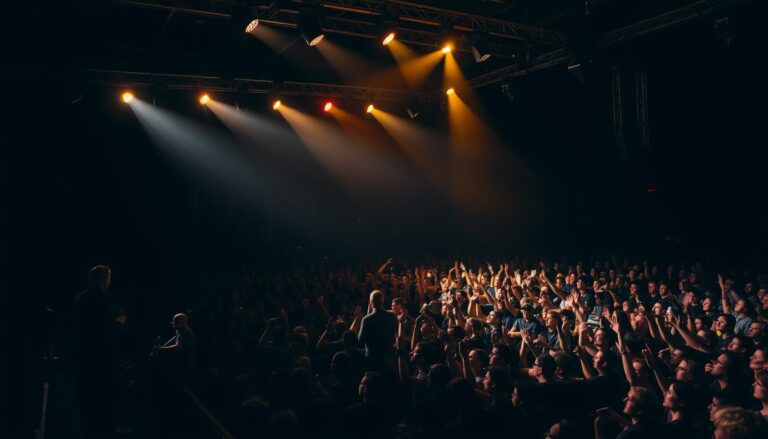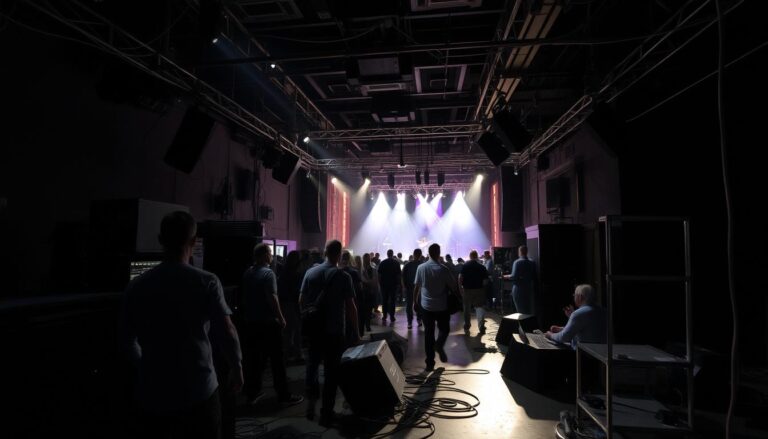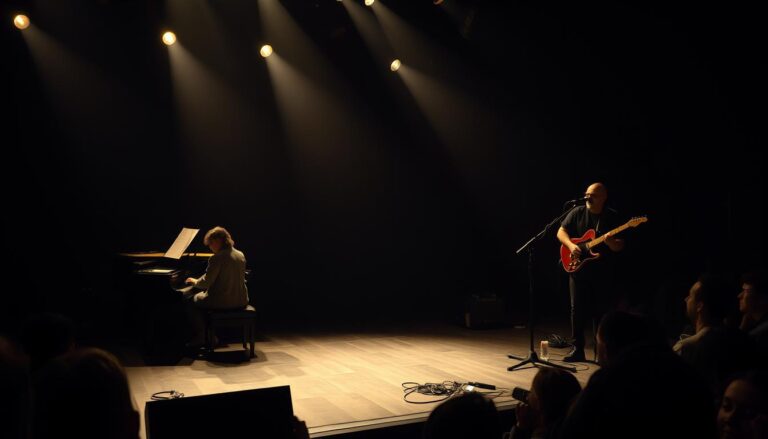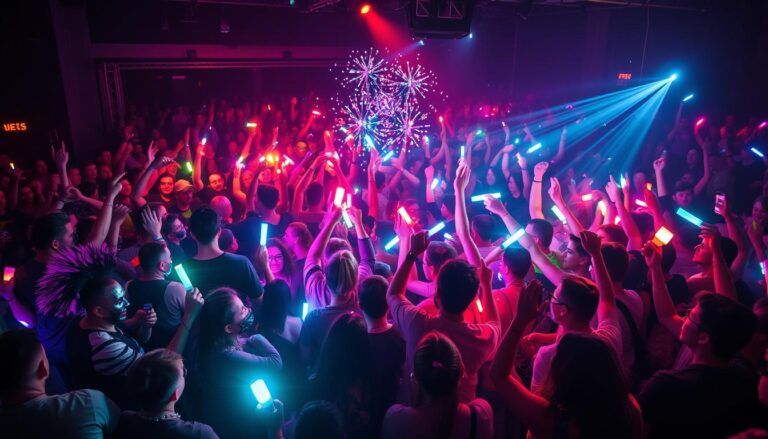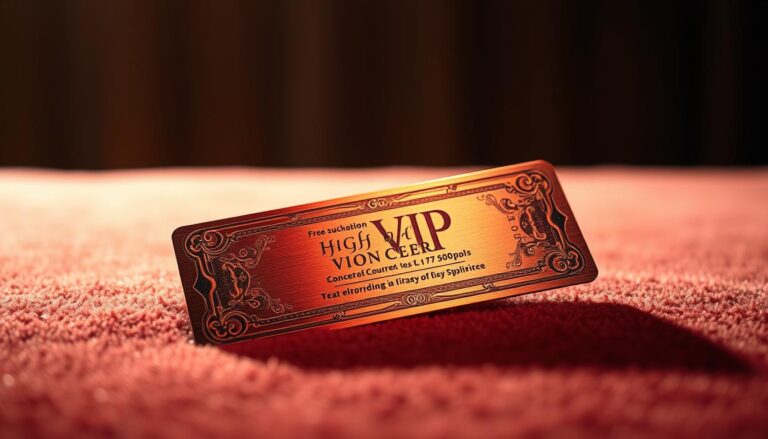Attending a concert or event can be an exhilarating experience, but understanding the rules around taking photos backstage can be confusing. Different artists and venues have varying policies in place, and not knowing these rules can result in being kicked out.
Knowing what’s allowed and what’s not can enhance your experience and ensure you don’t miss out on capturing memorable moments. Some artists are quite strict about their concert photography rules, while others are more relaxed.
Understanding these rules is crucial to avoiding any issues during the event.
Key Takeaways
- Research the artist’s and venue’s photography rules before attending the event.
- Be aware of any specific restrictions on camera equipment or flash photography.
- Respect the artist’s wishes regarding photography to avoid being ejected.
- Familiarise yourself with the venue’s policies on photography.
- Understand that some areas may be off-limits for photography.
The Unwritten Rules of Backstage Photography
When it comes to backstage photography, knowing the unwritten rules can make all the difference between getting the perfect shot and being asked to leave. These rules are not always explicitly stated but are crucial for maintaining a positive and respectful environment.
The Importance of Respect and Consent
Respecting artists’ privacy and obtaining consent when taking backstage photos is crucial. Consent is not just about asking permission; it’s about understanding the context and being mindful of the artist’s comfort level. As noted by a prominent photographer, “It’s not just about taking a great photo; it’s about respecting the moment and the person in it.” Being considerate and respectful can lead to a more positive experience for both the photographer and the artist.
Why Artists Value Their Privacy
Artists value their privacy for various reasons, including the need to maintain a professional image and to have personal space.
“As an artist, having control over your image is crucial. Backstage, we’re not always ready for a photo, and that’s our private moment.”
Understanding and respecting this need for privacy is essential for photographers.
Backstage Photo Policy Explained: The Official Guidelines
The rules governing backstage photography vary significantly across different venues and events, making it essential to understand these guidelines.
Standard Industry Practices
While specific policies can differ, there are standard industry practices that many venues and events adhere to. These include respecting artists’ privacy, not using flash photography, and limiting the type of equipment allowed backstage. Professional photographers are often required to obtain a press pass, which grants them official access to backstage areas.
How Policies Vary Between Venues
Policies can vary significantly between different types of venues and events. Understanding these differences is key to avoiding issues when attempting to take photos backstage.
Arena vs. Small Venue Differences
Large arenas typically have more stringent security and, consequently, more rigid backstage photo policies. In contrast, smaller venues might be more relaxed but still require adherence to specific rules. For instance:
- Large arenas may have restricted areas that are off-limits to all except authorized personnel.
- Smaller venues might allow more flexibility but still require permission from the artist or management.
Festival-Specific Considerations
Festivals often have unique backstage photo policies due to the multi-artist, multi-day nature of the events. Considerations include:
- Shared backstage areas may have specific rules to accommodate multiple artists.
- Some festivals may have designated times for backstage photography.
Being aware of these differences and adapting to the specific gig etiquette at each event is crucial for successful backstage photography.
Artist-Specific Photo Policies: Who Allows What
Backstage photo policies are not one-size-fits-all; they are as diverse as the artists themselves. Understanding these policies is essential for both professional photographers and enthusiastic fans.
Artists Known for Strict No-Photo Rules
Some artists maintain a strict no-photography policy backstage to preserve their privacy and control over their image. For instance, artists like Adele and Beyoncé are known for their stringent rules regarding backstage photography. These policies are often enforced by their management teams to ensure that the artists’ wishes are respected.
Musicians with Relaxed Photo Policies
On the other hand, some musicians adopt a more relaxed approach to backstage photography. Artists like Keith Urban and Powderfinger have been known to allow fans and photographers to take photos backstage, fostering a more intimate and engaging experience.
Australian Artists and Their Preferences
Australian artists also exhibit a range of preferences when it comes to backstage photography. For example, Gotye has been open to fans taking photos backstage, while Tame Impala prefers to limit photography to maintain a more private experience. The table below summarizes the photo policies of some prominent Australian artists.
| Artist | Photo Policy |
|---|---|
| Gotye | Relaxed |
| Tame Impala | Strict |
| Powderfinger | Relaxed |
| 5 Seconds of Summer | Moderate |
It’s clear that backstage photo policies vary significantly among artists, reflecting their individual preferences and boundaries. By understanding and respecting these policies, both photographers and fans can contribute to a positive and enjoyable experience for everyone involved.
The Legal Framework: Copyright and Privacy in Australia
Australia’s privacy and copyright laws significantly impact how backstage photos are taken and utilized. Understanding these laws is essential for photographers, artists, and fans to ensure compliance and respect for privacy and intellectual property.
Australian Privacy Laws and Photography
Australian privacy laws regulate how personal information, including images, is collected, used, and disclosed. Under the Privacy Act 1988, individuals have a right to expect that their personal information will be handled in a manner that respects their privacy. When it comes to backstage photography, this means being mindful of capturing and sharing images that may identify individuals or intrude upon their privacy.
Photographers should be aware that: taking photos of individuals in backstage areas may be considered an invasion of privacy if those individuals have a reasonable expectation of privacy.
Copyright Considerations for Backstage Photos
Copyright law in Australia is governed by the Copyright Act 1968. This law protects original works, including photographs, from being reproduced or distributed without permission. For backstage photos, the photographer typically owns the copyright, unless there’s an agreement stating otherwise.
Commercial Use Restrictions
Using backstage photos for commercial purposes can raise copyright issues. Commercial use includes selling the photos, using them in advertising, or incorporating them into merchandise. To use such photos commercially, photographers must either own the copyright or have obtained the necessary permissions or licenses from the copyright holder.

By understanding and respecting these legal frameworks, photographers and fans can enjoy capturing backstage moments while adhering to Australian law.
Professional Photographers vs. Fans: Different Rules Apply
When it comes to backstage access, professional photographers and fans are treated differently, with distinct rules applying to each group. Professional photographers often have more freedom and access due to their official role, while fans are typically subject to stricter guidelines.
Press Passes and Official Access
Professional photographers usually obtain a press pass, which grants them access to areas restricted to others. This pass is typically issued by the event organizers or the venue management. Having a press pass signifies that the photographer is there on official business, and they are expected to adhere to specific guidelines and protocols. For more information on press pass etiquette, you can refer to resources like David Simchock’s blog on photo pit.
What Fans with Backstage Access Can Expect
Fans who manage to gain backstage access, often through meet and greet opportunities, are subject to different rules. They are usually allowed to take photos, but with certain restrictions. For instance, flash photography might be prohibited to avoid disturbing the artists.
Meet and Greet Photo Etiquette
During meet and greets, fans are expected to be respectful and considerate. This includes being mindful of the time allocated for the meet and greet, not touching the artists without permission, and following any instructions given by the management or security personnel. It’s also considered polite to ask for permission before taking a photo, although this is often implicitly granted.
| Aspect | Professional Photographers | Fans |
|---|---|---|
| Access | Restricted areas with press pass | Limited to meet and greet areas |
| Photography Rules | Specific guidelines, often no flash | Generally allowed, no flash |
| Equipment | Professional cameras and lenses | Smartphones or basic cameras |
Red Flags: Actions That Will Get You Kicked Out
Certain behaviors at concerts can quickly turn a fun night into a disaster by getting you ejected. Understanding these red flags is essential for both fans and photographers to ensure a smooth and enjoyable experience for everyone involved.
Disrespecting Artist Boundaries
One of the most significant red flags is disrespecting the boundaries set by the artists or their management teams. This includes ignoring instructions not to take photos or videos in certain areas or during specific parts of the performance. Artists value their privacy, and violating these boundaries can lead to immediate removal from the venue.
For instance, some artists may have strict no-photo policies during certain songs or segments of their performance due to personal or professional reasons. Ignoring these rules not only jeopardizes your presence at the event but can also impact the overall experience for others.
Technical No-Nos (Flash Photography, Equipment)
Using inappropriate photography equipment or techniques, such as flash photography, can also be a significant red flag. Flash can be distracting and disrupt the performance, potentially causing discomfort to the artists or disturbing the audience’s experience.
Professional photographers are usually aware of these rules and are equipped with the right gear to capture high-quality images without causing a disturbance. Fans, however, should be cautious with their smartphone usage, ensuring that their photography does not disrupt the event.
Real Consequences: Security Intervention
The consequences of ignoring these guidelines can be severe. Security personnel are trained to intervene when they observe any behavior that is deemed disruptive or against the venue’s or artist’s rules. Being ejected from a concert is not only disappointing but can also result in a ban from future events.

In extreme cases, repeated or severe offenses might lead to further action, including legal repercussions, especially if the behavior causes harm or significant disruption.
How to Properly Request Photo Permission
Understanding the protocol for requesting photo permission backstage can make all the difference in having a successful and respectful photography experience. It’s about being considerate of the artists’ space while capturing memorable moments.
Approaching Management Teams
When it comes to requesting photo permission, one of the most effective ways is to approach the artist’s management team. They often have a clear policy regarding backstage photography. It’s crucial to contact them in advance to understand their requirements and obtain any necessary permissions. This not only shows respect for the artist’s privacy but also helps in avoiding any last-minute issues.
The Right Way to Ask Artists Directly
If you’re in a situation where you can directly ask the artist for permission, be polite and considerate. Explain your intentions and assure them that you respect their privacy. A straightforward and respectful approach can go a long way in getting a positive response.
Written Permission: Why It Matters
Obtaining written permission is a best practice, especially for professional photographers. It provides a clear record of the agreement and can help prevent misunderstandings. As part of good gig etiquette, it demonstrates a commitment to respecting the artist’s wishes and concert photography rules.
By following these guidelines, photographers can ensure that they are respecting the artists while capturing the moments that matter. It’s all about balancing the desire to take great photos with the need to respect the artists’ privacy and boundaries.
Australian Concert Scene: Unique Photo Policy Considerations
From the iconic Sydney Opera House to intimate festival settings, understanding the nuances of backstage photo policies is crucial for anyone looking to capture the essence of Australia’s live music scene.
Major Australian Venues and Their Policies
Australia is home to a diverse range of concert venues, each with its own set of rules regarding photography. For instance, the Sydney Opera House has strict guidelines to protect the integrity of performances, while other venues like Festival Hall may offer more flexibility.
Sydney Opera House vs. Festival Hall
The Sydney Opera House is renowned for its stringent policies, including restrictions on flash photography and the use of tripods, to ensure an uninterrupted performance. In contrast, venues like Festival Hall might have more relaxed rules, allowing for a different kind of concert experience.
Cultural Expectations Down Under
Australia’s cultural landscape significantly influences its concert scene, with a strong emphasis on respect for artists and their work. Understanding these cultural nuances is key to navigating backstage photo policies effectively.
Respecting the artist’s vision and boundaries is paramount. This not only includes adhering to the venue’s photo policy but also being mindful of the cultural context in which the concert is taking place.
By being aware of these factors, concert-goers can enjoy the rich musical offerings of Australia while respecting the rules and cultural norms that govern the live music experience.
Technology Considerations: Phones, Cameras, and Social Media
Backstage photography etiquette is heavily influenced by the technology we use, from smartphones to social media platforms. As we capture moments backstage, it’s essential to consider how our technology use impacts the artists and the overall experience.
Smartphone Photography Etiquette
When using smartphones for backstage photography, it’s crucial to be mindful of your surroundings and the people around you. Keep your device on silent mode to avoid distractions, and be aware of your flash settings, as they can be intrusive. Additionally, consider the storage capacity of your device and ensure you have enough space for photos.
Social Media Posting Guidelines
Sharing backstage photos on social media can be a great way to engage with fans, but there are guidelines to follow. Always check with the artist or their management team before posting any photos, especially if they’re not intended for public release. Be mindful of the content you share, respecting any privacy concerns or embargoes on certain images.
Geotagging and Privacy Concerns
Geotagging your photos can raise privacy concerns, as it can reveal the location of backstage areas or the artist’s whereabouts. Consider disabling geotagging or being cautious about the information you share. This helps maintain the privacy and security of the artists and the venue.
By being considerate of these technology considerations, you can help ensure a positive experience for both yourself and the artists. Remember, the key to great backstage photography is respect—respect for the artists, their space, and the technology you use.
Success Stories: Respectful Photography That Artists Appreciated
Photographers who adhere to backstage photo policies have often received appreciation from artists, leading to positive experiences for both parties.
Case Studies from Australian Concerts
Several Australian concerts have showcased the positive impact of respectful photography. For instance, during a concert in Sydney, a photographer was commended by the artist for respecting their no-flash policy, resulting in high-quality images that benefited both the artist and the photographer.
“The photographer’s professionalism and respect for our wishes made a significant difference in our experience. It was a pleasure to work with someone who understood our needs.” – Artist Management Team
| Concert Venue | Artist’s Policy | Photographer’s Action | Outcome |
|---|---|---|---|
| Sydney Opera House | No Flash Photography | Respected the policy | Positive feedback from artist |
| Melbourne Arena | Restricted Backstage Access | Adhered to restricted areas | Allowed to take exclusive photos |
How to Create Positive Experiences
To create positive experiences, photographers should focus on understanding and respecting the artist’s photo policies. This includes being aware of specific rules such as no flash, restricted areas, or specific poses.
- Research the artist’s policy before the event
- Communicate with the artist’s management team
- Be mindful of your equipment and surroundings
Building Reputation as a Respectful Fan
Building a reputation as a respectful fan or photographer involves consistently adhering to the rules and showing professionalism. This can lead to better opportunities, such as exclusive access or recommendations to other artists.
Conclusion: Balancing Fandom and Respect
Balancing the enthusiasm of being a fan with respect for artists and their policies is key to a positive concert experience. Understanding concert photography rules and backstage photo policy explained guidelines helps ensure that both fans and artists enjoy the event without any issues.
By being mindful of the rules and respecting artists’ boundaries, fans can help create a welcoming environment. This not only enhances the experience for everyone involved but also fosters a positive relationship between artists and their audience.
As the Australian concert scene continues to thrive, it’s essential for fans to stay informed about the specific policies in place at various venues. By doing so, they can enjoy the event while respecting the artists’ wishes, ultimately contributing to a more enjoyable experience for all.
